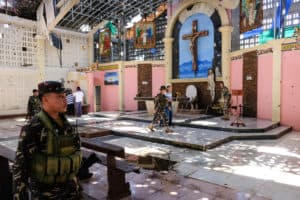Repairing Christian-Muslim ties in devastated Filipino city
Reinhard Backes, our desk officer for the Philippines, recently returned from a fact-finding mission to Marawi City, the Philippine city which was under siege from Islamists for May to October last year. Christians were suppressed by the radical insurgents, and a number of them were kept as hostages. The liberation of Marawi City by the army came at a cost of enormous damage. According to official figures, 920 extremists, 165 soldiers and 45 civilians were killed in the fighting. Reinhard discusses the current state of affairs.

Christians were taken hostage, among them a priest.
Many hostages were taken, the majority of whom were Christians. St. Mary’s Cathedral was one of the first sites targeted by the extremists in the city. They probably wanted to take Bishop Edwin de la Peña of Marawi as a hostage, but he was not in the city center at the time. And so they took the vicar general, Father Teresito Suganob, along with other believers, instead. However, the Islamists also took hostages from among the Muslims, those whom they accused of collaborating with the Christians.
Was Saint Mary’s Cathedral defiled or desecrated in any way?
The church is pretty much completely destroyed, including all sculptures, statues of Our Lady and crucifixes. I saw a statue of the Virgin Mary that had been beheaded. They probably burned the head. All that was left was the clothed corpus. From an architectural standpoint, the cathedral is a rather simple, hall-like structure. Marawi is mostly Muslim and so it was not acceptable to build an overly conspicuous Christian church. The Catholic community there has only a few thousand members, who are scattered for the time being.
What was the relationship like between Christians and Muslims before the Islamists invaded?
Just as in other countries where Christians are only a small minority among Muslims, such as is the case in Pakistan, Christians in Marawi have always tried to establish a good relationship with their Muslim neighbors. This is also the reason why Christians usually maintain close ties to Muslim authorities, and Marawi was no exception. The vast majority of Muslims also just wanted to coexist peacefully with their neighbors. The relationship between Muslims and Christians in Marawi was mostly friendly. Now, however, a certain degree of distrust is evident.
How is Bishop de la Peña handling the situation?
Bishop de la Peña is very keen on reconciling the two sides. That is why he has not made rebuilding the cathedral a top priority. He is focusing on strengthening the feeling of community and rebuilding relations between peoples and religions.
Have specific projects been developed to work towards these goals?
The diocese has launched a number of initiatives. One of these is a rehabilitation center, which offers assistance to more than 200 people who were held captive for months and who suffered both physical and emotional torment. The center is open to both Christians and Muslims. The counselling services include group and individual therapy sessions for women, girls and teenagers who have been raped; for men who suffered violence; and for children who need to be reintegrated into daily life following the terrible experiences they lived through.
Then there is a project called “Youth for Peace;” this involves more than 180, mostly Muslim students at Mindanao State University to visit refugee camps. Thousands upon thousands of people fled the city center during the conflict and they are now living in camps that were set up outside of the city. The objective of “Youth for Peace” is to give these refugees—Muslim and Christians alike—a sense that there is an effort underway to recreate peaceful coexistence.
How is Aid to the Church in Need supporting these projects?
We are active on a number of fronts. We provided emergency relief for the refugees during the conflict. Now we would like to help make sure that the rehabilitation center can continue its work. So far, two vehicles have been donated. Further aid is planned. We are also talking about helping to set up shelters for the refugees who have been living for months in tents. With tropical temperatures far exceeding 80 degrees, conditions inside the tents are almost impossible to endure. Add to that heavy rainfall. Tents are therefore not a long-term solution. Instead, the provision of small, temporary houses is being discussed; simple structures that could meet the needs of the refugees for the time being. ACN may get involved in this plan. The rebuilding of the city will take many years in any case.
What are your thoughts now after your trip?
On the one hand, it is quite dramatic to see how Islamists have destroyed an entire city, an established culture. On the other hand, I was very surprised by the people of Marawi. Their situation may be catastrophic, but they have hope and they are taking action. I learned how important their Catholic faith is to them—the selfless concept of charity, which can be seen in the concrete aid being offered to the victims. And it was very encouraging to see how openly the young volunteers, both Muslims and Christians, interact with each other. Many said that, by working together, they are coming to better understand the beliefs of the others—and that, at the same time, they are being strengthened in their own sense of identity.
—Maximilian Lutz

